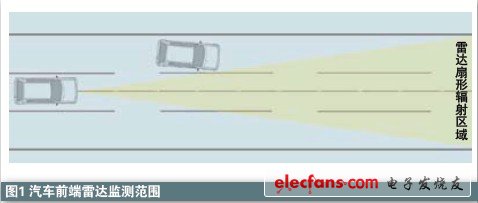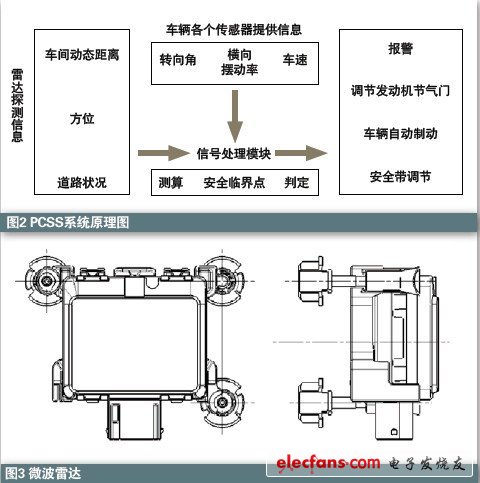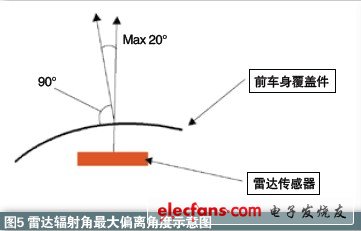Automobile safety performance is an important issue in the development of automotive technology. In order to improve the driving safety performance of vehicles, various advanced technologies are applied to automobiles. The following small series introduces the application of automotive radar in new active safety system vehicles, and explains its system structure, working principle and design ideas; I hope it can play a guiding role in the future research and development of active safety performance. Automobile's active safety technology can prevent accidents from happening, and is increasingly valued by major car companies and consumers. More advanced technologies are also applied to it. The pre-collision safety system and adaptive cruise control system with radar ranging technology as the core have become new targets for active safety systems in recent years. Pre-crash safety system Pre-Collision Safety System (Pre-Collision Safety System) referred to as PCSS, which is mainly composed of real-time monitoring radar, various sensors, signal processing modules, alarm modules and actuators; the core technology of the system is to use the radar device installed in the front of the vehicle Measure the distance of the dynamic vehicles and obstacles ahead, and feed back the measured vehicle and obstacle information to the system signal processing module (see Figure 1). The signal processing module integrates the radar feedback information with the various sensor information of the vehicle to calculate the relative distance and relative speed of the vehicle with the PCSS system and the obstacle in front. When the distance and speed cannot meet the minimum safety value preset by the system, the actuator will activate the safety device on the vehicle to assist the driver to control the driving of the vehicle to achieve the goal of active anti-collision. The auxiliary control made by the actuator for the safety hazard level is as follows: the first is to adjust the engine throttle opening to reduce the vehicle power output; the second is to brake the vehicle to prevent the vehicle from colliding or to reduce the degree of collision; the third is to tighten Seat belt to prevent injuries to passengers (see Figure 2). Adaptive cruise control system The Adaptive Cruise Control System (AdapTIve Cruise Control System) is called ACC for short, and the system works basically the same as the pre-crash safety system. During the driving of the vehicle, the distance sensor (radar) installed at the front of the vehicle continuously scans the road condition in front of the vehicle, while the wheel speed sensor collects the wheel speed signal. When the road ahead of the ACC system vehicle is clear, the cruise speed control sets the speed according to the driver ’s wishes and keeps driving at a constant speed; the current obstacle appears or the distance to the vehicle in front is too small, the ACC control unit can pass the The dead system and the engine control system coordinate actions to make the wheels brake properly and reduce the output power of the engine, so that the vehicle can always maintain a safe distance from the vehicle in front. When the adaptive cruise control system controls the vehicle braking, the braking deceleration is usually limited to a level that does not affect comfort. When a larger deceleration is required, the ACC control unit will emit a sound and light signal to inform the driver to take the initiative动 æ“作。 Move operation. When the distance to the preceding vehicle increases to a safe distance, the ACC control unit controls the vehicle to travel at the set speed. Radar classification and overview According to different measurement media of radar, vehicle radar can be divided into ultrasonic radar, infrared radar, lidar and microwave radar. Due to the relatively short detection range of ultrasonic radar and infrared radar, it is currently mainly used in vehicle reversing control systems. Lidar and microwave radar have the advantages of long range and high accuracy, and are widely used in automotive active safety systems. Lidar can be divided into pulse type and phase type according to different measurement principles. Lidar has the advantages of relatively simple structure, high precision, high directivity, long detection distance, ability to recognize road conditions and cheap product prices. The pre-collision system using lidar first extracts useful data from the vehicle distance and bearing data obtained from the laser scanning radar, and estimates the vehicle path based on the dynamic characteristics of the following vehicle. The radius R1 estimated for the first time and the radius R2 estimated for the second time based on the vehicle speed and the yaw rate are determined. However, the optical performance of lidar is susceptible to environmental factors. In rain, fog, sand and snow, its measurement performance will be reduced. Because the target signal received by the lidar will contain interference sources, it can only transmit relative distance information when applied to the pre-collision system, and the signal processing module accurately and quickly calculates the distance information to obtain relative vehicle speed information. Microwave radar can be divided into pulse frequency modulation (PFM) and frequency modulation continuous wave (FMCW) according to different measurement principles. Microwave radar (as shown in Figure 3) uses millimeter electromagnetic waves as the detection medium, and its wavelengths are all in the millimeter order, so it can also be called millimeter wave radar. Microwave has the advantages of long detection distance, strong head wearing ability, reliable operation and good real-time performance. And the measurement performance is less affected by external factors such as environment and weather, and the distance and relative speed information of the PCSS system vehicle and the target vehicle in front can be directly detected and obtained. In the active safety system, the microwave frequency used by the radar is mainly concentrated in three frequency bands, namely 23GHz ~ 24GHz, 60GHz ~ 61GHz, 76GHz ~ 77GHz. The microwave radiation energy attenuation characteristics in these three specific frequency bands are large, which limits the propagation of radar signals to a more reasonable range, thereby reducing the impact on other vehicle radar and wireless communication equipment, and reducing the impact on the surrounding human body radiation. Radar layout requirements In order to meet the normal use of PCSS and ACC system functions, the radar is generally arranged in the space area between the front end of the vehicle 300mm ~ 1000mm from the ground and within ± 500mm of the horizontal center axis of the vehicle (see Figure 4). Covers that may exist on the front of the radar in this area, such as bumpers, radar radomes, radiator grilles, or vehicle brand logos. The ideal microwave radar layout position is that there is no cover in front or only a plastic material cover, because the metal cover will affect the microwave radar information feedback. If the radar must be installed behind some covers, in order for the radar to fully perform its original functions, special attention should be paid to the material selection, structural design, and relative position of the covers with other surrounding parts. During system vehicle use, water droplets, water films, and snow on the front cover of the radar may cause additional signal attenuation and further limit performance and functionality. Micro inverter is a small inverter used in solar power generation systems, its main function is to convert the direct current generated by a single Solar Panel into alternating current. Unlike traditional centralized inverters, microinverters are usually equipped with one per solar panel, that is, each solar panel has an independent microinverter. grid tie micro inverter, off grid solar micro inverter, hoymiles microinverter price, micro inverter solar system, solar system with micro inverters Ningbo Autrends International Trade Co., Ltd. , https://www.aitsolarpanels.com



Main effect:
1. Individual control: The microinverter provides independent conversion control for each solar panel, which means that each solar panel can optimize its power output individually. This maximizes the power generation efficiency of the solar panels since shading or other influences only affect the power generation efficiency of individual panels, not the entire array.
2. Reliability: Since each solar panel is equipped with a micro-inverter, even if one of the inverters fails, the other panels can still work normally, thereby improving the reliability of the entire system.
3. Flexible installation: Micro-inverters are usually small and can be installed near solar panels without being concentrated in one location, so installation is more flexible and convenient.
Differences from other inverters:
1. Individual control: Compared with traditional centralized inverters, microinverters provide independent conversion control for each solar panel, enabling each panel to reach its maximum power output.
2. Fault isolation: The micro-inverter has the function of fault isolation. Even if one of the inverters fails, other panels can continue to work without affecting the operation of the entire system.
3. Installation method: The micro-inverter can be flexibly installed near the solar panel, and does not need to be concentrated in one location, so the installation is more flexible and convenient.
4. Applicable scale: micro-inverters are usually used in small-scale solar power generation systems, while traditional centralized inverters are suitable for larger-scale photovoltaic power plants.
Overall, the main role of microinverters is to individually control and optimize the power generation efficiency of solar panels and improve the reliability of the system. Compared with traditional centralized inverters, it has some advantages in terms of flexibility, fault isolation and applicable scale.